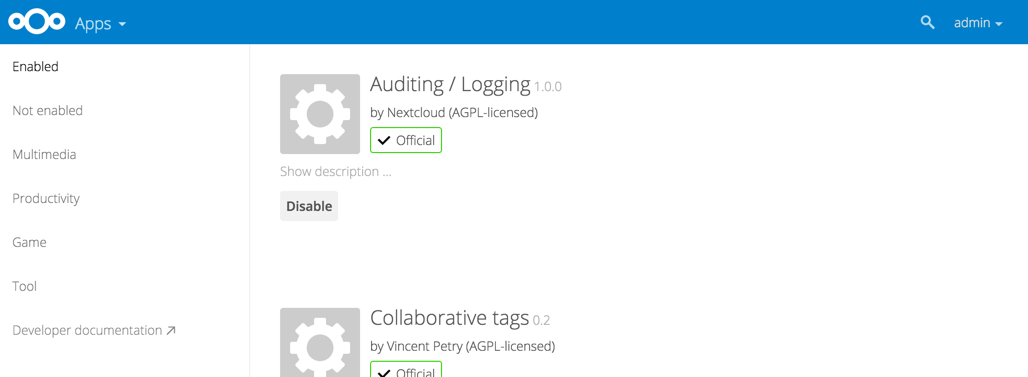Installing and Managing Apps¶
After installing Nextcloud, you may provide added functionality by installing applications.
Supported Apps¶
See Supported Apps for a list of supported apps.
Viewing Enabled Apps¶
During the Nextcloud installation, some apps are enabled by default. To see which apps are enabled go to your Apps page.

You will see which apps are enabled, not enabled, and recommended. You’ll also see additional filters, such as Multimedia, Productivity, and Tool for finding more apps quickly.
Managing Apps¶
In the Apps page you can enable or disable applications. Some apps have
configurable options on the Apps page, such as Enable only for specific
groups, but mainly they are enabled or disabled here, and are configured on
your Nextcloud Admin page, Personal page, or in config.php.
Adding Third Party Apps¶
Some apps are developed and supported by Nextcloud directly. These have an Official tag. Apps with the Approved tag are community-developed and supported; they are maintained by trusted developers, and are under active development. Only Official and Approved apps are linked on the Apps page by default.
Click the app name to view a description of the app and any of the app settings in the Application View field. Clicking the Enable button will enable the app. If the app is not part of the Nextcloud installation, it will be downloaded from the app store, installed and enabled.
Sometimes the installation of a third-party app fails silently, possibly because
'appcodechecker' => true, is enabled in config.php. When appcodechecker is
enabled it checks if third-party apps are using the private API, rather than the public
API. If they are then they will not be installed.
Note
If you would like to create or add your own Nextcloud app, please refer to the developer manual.
Using Custom App Directories¶
Use the apps_paths array in config.php to set any custom apps directory
locations. The key path defines the absolute file system path to the app
folder. The key url defines the HTTP web path to that folder, starting at
the Nextcloud web root. The key writable indicates if a user can install apps
in that folder.
Note
To ensure that the default /apps/ folder only contains apps shipped with Nextcloud, follow this example to setup an /apps2/ folder which will be used to store all other apps.
<?php
"apps_paths" => array (
0 => array (
"path" => OC::$SERVERROOT."/apps",
"url" => "/apps",
"writable" => false,
),
1 => array (
"path" => OC::$SERVERROOT."/apps2",
"url" => "/apps2",
"writable" => true,
),
),
Using Your Own Appstore¶
You can enable the installation of apps from your own apps store. This requires that you can write to at least one of the configured apps directories.
To enable installation from your own apps store:
Set the appstoreenabled parameter to “true”.
This parameter is used to enable your apps store in Nextcloud.
Set the appstoreurl to the URL of your Nextcloud apps store.
This parameter is used to set the http path to the Nextcloud apps store. The appstore server must use OCS.
<?php
"appstoreenabled" => true,
"appstoreurl" => "https://api.nextcloud.com/v1",